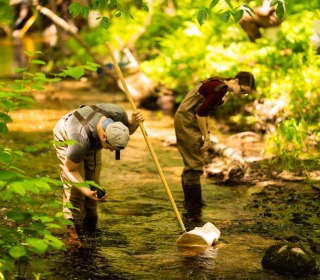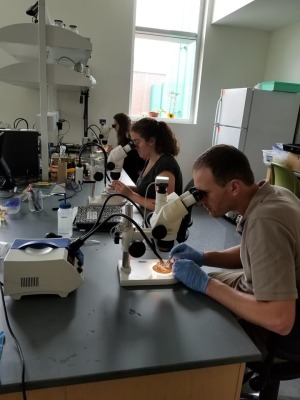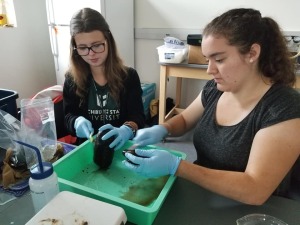Collaboration is about more than just teamwork.
It’s also about creating synergy, where the combined effort is far greater than the sum of its individual parts.
At Fitchburg State University, a large-scale collaboration effort among faculty and nearly 30 undergraduate students in the math, biology, chemistry and environmental, geographic and public health sciences, has proven to be the driving force, as eight faculty members recently saw its new and in-depth research published.
“This publication is several years in the making,” said Biology Professor Daniel Welsh. “The research happened during the summers of 2017-2020, but then it has taken us several years to analyze and put into a broader scientific framework. It’s fulfilling to see it finally published after all these years of hard work.”
The article, "Assessing Taxonomic and Functional Responses of Stream Macroinvertebrate Communities to Multi-Scale Influences of Urban Land Cover" is available online in the journal River Research and Applications. This is the second published paper to come from this work. The first paper – focusing on the fish in the streams – was published in 2023 in the journal Environmental Biology of Fishes.
The authors included current faculty members John Ludlam, Daniel Welsh, Aisling O'Connor and Emma Downs (from the Biology and Chemistry Department); Elyse Clark, Elizabeth Gordon and Jane Huang (from the Environmental, Geographic and Public Health Sciences Department).
The newly published research, according to Professor Ludlam, found that, “streams with more urban development upstream had increased levels of dissolved salts, and some streams exceeded safe levels for invertebrate life. This finding contributes to the growing awareness that winter road salting can have negative effects on stream health.”
The study investigated the responses of benthic macroinvertebrate assemblages to land cover and local habitat conditions across 22 stream sites in the local Nashua River watershed.
The research work of the undergraduate students was conducted as part of the Summer Research Collaborative, a program that received funding from multiple granting agencies between 2017 and 2020.
“All of the faculty and students worked together to make this research project a success, but this work couldn’t have been done without the student research assistants,” said Welsh. “They were integral in collecting all of the data. I feel that this is a testimony to the great work we do with students and the effects we can have on the world around us beyond the classroom.”
Professor Gordon agreed that the students were at the heart of this collaborative effort.
“The summer research collaborative was originally envisioned to increase student participation in research projects on our campus, not only to strengthen their research skills for career readiness, but also to improve their confidence as STEM scholars and promote graduate school attendance,” Gordon said.
As part of this project, biology faculty conducted invertebrate and stream fish sampling and identification; chemistry faculty analyzed water chemistry; faculty from environmental, geographic and public health sciences sampled stream flow, sediments and microplastics; and along with math faculty, used computer geographic information systems to map the watershed. The collaboration of faculty from several STEM fields was a unique aspect of the research, allowing them to address important scientific questions about stream health from a multidisciplinary perspective.
I hope that (the faculty members) are proud of what they were able to accomplish and are proud of the students they mentored. I certainly cannot speak for everyone on the project, but this project did change my life. I’m happy to see that it’s still producing fruit to this day, and I hope future researchers can continue to use the data we’ve collected.
The research project was significantly shaped by the hands-on contributions of numerous Fitchburg State University undergraduate students, who gained valuable knowledge throughout the process. And because of the multidisciplinary nature of the research, students were exposed to field sampling and laboratory techniques beyond those needed for their specific research project.
Caroline Anderson ‘20, who earned a degree in environmental and earth science, says that the Summer Research Collaborative was an integral component to her undergraduate degree. She participated first as a student researcher in 2018, and again as a mentor to the incoming students during the summer of 2019.
“It is a highlight of my professional career to have been a part of the recently published paper,” said Anderson, who works as an environmental analyst II at the Massachusetts Department of Conservation and Recreation. “Seeing the results of the field work we conducted as a group be analyzed and published for the public to review and potentially inspire other scientists is truly an honor.”
Annie Vincent (Saball) ‘19 assisted for two summers in the Summer Research Collaborative, and graduated with a bachelor’s in biology and a second major in environmental and earth science, and a minor in chemistry. She currently is an aquatic field ecologist for the National Ecological Observatory Network (NEON), a continental-scale observation facility collecting long-term ecological data operated by Battelle, funded by the USNSF.
“This project was my first introduction to real field work, aside from the handful of days we spent in the woods near the university in ecology class,” Vincent said. “Once I had my taste for field work, I never wanted to sit behind a desk again. Besides the scientific knowledge and experience I gained from this, it also changed the course of my career. Most of the skills and collection methods we used in this project I am using today, at my current job, such as backpack-electrofishing and Surber sampling for macroinvertebrates.”
Vincent says she is proud to have been a part of such a successful project.
“I hope that (the faculty members) are proud of what they were able to accomplish and are proud of the students they mentored,” she said. “I certainly cannot speak for everyone on the project, but this project did change my life. I’m happy to see that it’s still producing fruit to this day, and I hope future researchers can continue to use the data we’ve collected.”
This study investigated the taxonomic and functional responses of benthic macroinvertebrate assemblages to urban land cover and local habitat conditions across 22 stream sites in the Nashua River watershed of Massachusetts and New Hampshire. Using a multi-scale approach, they analyzed land use at watershed, riparian, and reach scales and assessed in-stream environmental factors, including water quality, substrate composition, and canopy openness.
Results indicate that while urban land cover was correlated with increased conductivity and pH, macroinvertebrate taxonomic and functional diversity was more strongly influenced by local habitat conditions such as dissolved oxygen, nitrate levels, and stream width.
Sensitive taxa declined in urbanized areas, while opportunistic species with traits favoring rapid reproduction increased. These findings underscore the importance of localized habitat management in maintaining stream biodiversity and highlight the utility of functional trait analysis in urban stream ecology.
The research showed that urbanization profoundly impacts stream ecosystems, leading to altered hydrology, degraded water quality, and shifts in biological communities, a phenomenon known as the “urban stream syndrome.”
The students involved with the project had the opportunity to interact and work with the professors outside of a classroom setting.
“Although they were leading the project, guiding, and mentoring us, we worked alongside them as peers,” Vincent said. “This allowed for a bond to be built between the professors and the students, which, in my opinion, was important for the rest of my college career since I became more likely to ask questions and give feedback in the classroom. This bond has also been upheld with most of the faculty, even to this day, years later. Most professors want their students to succeed, but we were shown this in a way that a classroom setting could not. They spent precious hours with us, organizing the data and repeatedly sitting through final presentation practice sessions.”
Anderson admits that the professors who led the Summer Research Collaborative have had a significant impact on her life.
“Being out in the field for hours of the day, you get to build personal connections with the professors that you may not get in a classroom of 50 students,” she said. “The professors were truly encouraging both during and after the Summer Research Collaborative. During the program, I talked with some of the professors on their experiences during their undergraduate and graduate programs. Without the professors, many of the most memorable and influential moments of my undergraduate degree would not have been possible and I will be forever grateful to them.”
Photo: by Ian Murray
Students collecting samples of macroinvertebrates from a stream.


